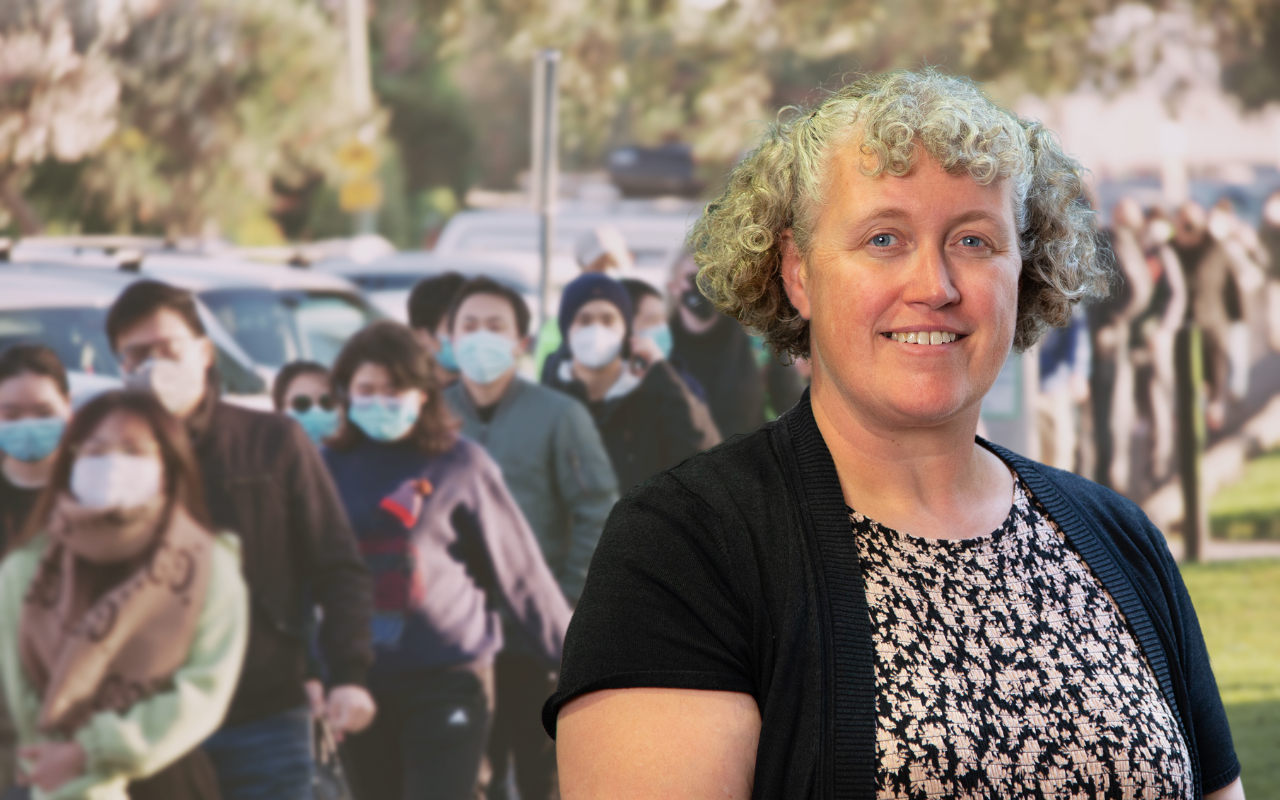The experience of Australians with long COVID can help inform responsive and effective health care, writes occupational therapist Dr Danielle Hitch …
Post-coronavirus disease 2019 (COVID-19) condition (“long COVID”) causes hundreds of symptoms across multiple organ systems, presenting a huge challenge to a health system already under unprecedented pressure from the COVID-19 pandemic.
Many patients have the classic post-viral problems of fatigue and brain fog, but various possible symptom constellations exist. Some of the less well known symptoms our patients have raised include incontinence, digestive complaints, hair loss and dizziness.
That’s before you even start to consider the impact of the social determinants of health. Some of these factors present medical risks (such as Indigeneity and social isolation), and others pose risks to participation in daily life (such as unemployment and substance misuse). Older age, chronic disease, low levels of education, and belonging to culturally and linguistically diverse communities raise both medical and functional risk in regards to recovery from COVID-19.
Given its recency, we find ourselves in the unfamiliar and uncomfortable position of operating without an established, rigorous evidence base for practice.
We are trying to “build the plane at the same time as flying it”, which raises some interesting questions about expertise.

Uniquely, the syndrome was first identified and named by patients networking on Twitter, with the term “long COVID” quickly gaining clinical, political and community recognition.
However, the World Health Organization’s International Classification of Diseases refers to the illness as “post COVID-19 condition”, with other expert agencies using their own terminology and inclusion criteria.
These multiple definitions make it hard to generalise research findings and increase barriers between health experts and lived experience experts (ie, patients and carers).
Anyone in health claiming to be an expert in long COVID would need an in-depth understanding of practically every clinical specialty — a tall order indeed!
The ongoing Australian Government Inquiry into long COVID and repeated COVID-19 infections has put this complex syndrome in the spotlight.
In addition, lived experience research in long COVID is emerging, and my research team recently published the first Australian study in this area.
The aim was to describe and contextualise COVID-19 recovery to inform Australia’s evolving policy and practice responses.
We completed 37 narrative interviews with adults approximately six months after they had COVID-19, of which 25 met the WHO case description for long COVID.
The study was not limited to people self-identifying with long COVID because the case description specifies the symptoms of this syndrome “cannot be explained by an alternative diagnosis”.
In our experience, many people with pre-existing conditions such as diabetes, mental health conditions and obesity experience exacerbations following COVID-19, increasing their need for care.
Since one in five Australians live with chronic diseases, we may be significantly underestimating the impact of long COVID on the health system and adopting a limited focus on younger, previously fit patients.
In lieu of preventing infections, we also need early intervention strategies that stop long COVID developing such as rapid access to community rehabilitation services. So, it is important to understand all phases of recovery from COVID-19.
Recovery trajectories
The first theme in our study described the trajectories of recovery.
About a third of participants (mostly aged under 30 years) quickly and completely recovered from acute symptoms.
The rest described gradual improvement but still had symptoms that affected daily life, with some experiencing periodic relapses of existing symptoms (eg, fatigue and breathlessness) or the re-emergence of previously resolved symptoms (eg, disordered smell or headaches).
As described by one person: “It gets really hard, then you get better, and then it comes back and hits you a second time”.
Providing the right care at the right time and place remains an ongoing challenge for Australian health care, particularly for patients with fluctuating conditions who often struggle to reconnect with care during relapses.
Returning to “my normal”
The second theme was returning to “my normal”, which the patients identified as their ultimate recovery destination.
Their recovery was defined by and described within the context of their personal circumstances and did not necessarily mean being symptom-free.
A patient with chronic asthma may not perceive breathlessness as a big problem, but this symptom could be an overwhelming barrier in daily life for someone who never had it before.
Being told all their test results were normal (when in their experience, it was not) was far from reassuring.
Tales of being “gaslit” or dismissed consistently appear in long COVID consumer stories, sometimes causing patients to turn away from mainstream health care.
Many of our participants described leaving appointments feeling as though all the practitioner saw was their age, a pre-existing condition, or their anxiety.
For our participants, good experiences with practitioners included validation of their experience, honesty about the limits of what could be offered and practical advice about self-management. For example; the Royal College of Occupational Therapists has a comprehensive list of strategies to support people with long COVID in daily life based on the 3Ps principle – pace, plan and priorities.
Patients don’t expect their health care providers to know everything, with many also voicing uncertainty about the cause of their symptoms.
Practitioners who explicitly acknowledged the patients lived experience were perceived as allies in care and empathetic to the patient’s struggles with recovery, which support strong and enduring therapeutic relationships.
Back to work
The final theme emphasised that work is a tangible sign of recovery for many patients.
About half our participants were health care workers, and their return to work often provoked considerable stress related to their high risk of re-exposure.
Return to work processes were often described as onerous, with paperwork and bureaucratic tasks especially difficult for patients with fatigue and brain fog.
Many returned to their previous role but found its physical and cognitive demands provoked a “crash” that returned them to sick leave.
Specialised vocational rehabilitation (including graded return and timely rehabilitation) is essential for a sustainable return to work, although research suggests some people with long COVID leave the workforce permanently.
Australians with long COVID currently have inconsistent access to this support, with only a handful of dedicated long COVID clinics operating in Australia.
Lived experience is a powerful tool for responsive, relevant, efficient and effective health care.
It is not a case of “us versus them”, many of you reading this will be experiencing (or have recovered from) long COVID.
Lived experience must be meaningfully integrated into our national response from its conception.
Disadvantaged Australians are virtually invisible in our current debates on long COVID, despite its compounding effect on their challenges in daily life.
We must give patients flexible opportunities to contribute that reflect all the diversity and intersectionality of Australian life, which will require investment in measures such as interpreters, culturally appropriate approaches to participation and accessible information and meeting venues.
It’s an ethical imperative that we recognise patients’ lived expertise with appropriate payment. No expert (lived experience or otherwise) should be expected to pay out of their own pocket to share their hard-earned knowledge.
Meaningful engagement with lived experience experts demands building partnerships and enabling shared leadership of direct care, organisational design and governance and policy development. There are many ways this can be achieved, including co-design of models of care and services, consumer participation in decision-making committees, and patient-led research strategies.
The impact of long COVID on our community is too broad and deep to waste the rare opportunity for transformation offered by the COVID-19 pandemic.
Now is the time to truly recognise that expertise takes many forms, and the presence and inclusion of lived experience expertise is non-negotiable.
Dr Danielle Hitch is an occupational therapist and a Senior Research Fellow at the School of Health and Social Development at Deakin University in Geelong and Western Health in Melbourne.
The statements or opinions expressed in this article reflect the views of the authors and do not necessarily represent the official policy of the AMA, the MJA or InSight+ unless so stated.
Subscribe to the free InSight+ weekly newsletter here. It is available to all readers, not just registered medical practitioners.
If you would like to submit an article for consideration, send a Word version to mjainsight-editor@ampco.com.au.

 more_vert
more_vert
Are there any studies showing that rapid access to rehabiliation to prevent long covid has been found to be beneficial in reducing length of severity of illness? When would be do this- day 1 or day 20 of covid ? Who would fund this?